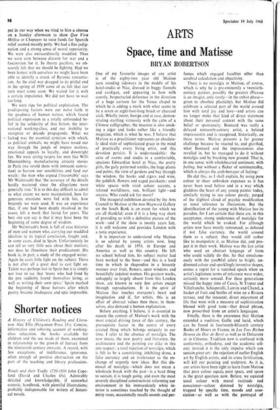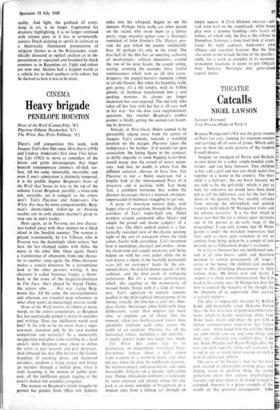Space, time and Matisse ARTS
BRYAN ROBERTSON
One of my favourite images of any artist is of the eighty-two year old Matisse seen standing sideways in the middle of his hotel-studio at Nice, dressed in baggy flannels and cardigan, and appearing to bow with courtly, bespectacled deference in the direction of a huge cartoon for the Vence chapel to which he is adding a mark with what seems to be a seven or eight-foot-long brush or charcoal stick. Wholly intent, benign and at ease, demon- strating startling virtuosity with the calm of a Chinese calligrapher, the maestro is also smok- ing a cigar and looks rather like a friendly magician, which is what he was. I believe that Matisse as a practitioner represents an absolute- ly ideal state of sophisticated grace in the mind of practically every living artist, and this devotion persists. It is understandable : the suite of rooms and studio in a comfortable, spacious Edwardian hotel at Nice, the pretty girls, the gaily patterned textiles, the huge plants and palms, the view of gardens and bay through the window, the books and cigars and wine, the goldfish, flowers and caged parakeets: cool white spaces with vivid colour accents, a relaxed worldliness, sun, brilliant light—and success. Who could ask for more?
The inaugural exhibition devoted by the Arts Council to Matisse at the new Hayward Gallery on the South Bank is an event for which we are all thankful; even if it is a long way short of providing us with a definitive picture of the work—and if the show is twenty years late, it is still welcome and provides London with a tonic experience.
It is important to understand why Matisse is so adored by young artists now, long after his death in 1954, in Europe and America as well as this country. He left no school behind him, his subject matter had been worked to the bone—and this is a hard time in which to rhapsodise in a leisurely manner over fruit, flowers, open windows and beautifully indolent women. His greatest works, unhappily so largely absent from this London show, are known to very few artists except through reproductions. It is the spirit of Matisse that touches everyone's heart and imagination and if, for artists, this is an affair of abstract values then these, in them- selves, also demand a human explanation.
Before anything, I believe, it is essential to equate the content of Matisse's work with the most crucial driving force of this century, the prerequisite factor in the centre of every created thing which belongs uniquely to our time. I refer to the absence of nostalgia. The new music, the new poetry and literature, the architecture and the painting are alike in this one respect: a total rejection of nostalgia, which is felt to be a constricting, inhibiting dross, a false currency and an irrelevance to the ex- change of urgently new ideas. But this dis- missal of nostalgia—which does not mean a wholesale break with the past—is a hard thing to sustain, it is tough going, and even the most severely disciplined constructivist reforming our environment in his immaculately white in- terior is sometimes touched by the thought of misty roses, occasionally recalls sounds and per-
fumes which engaged faculties other than cerebral calculation and objectivity.
There is no nostalgia in Matisse, of course, which is why he is pre-eminently a twentieth- century painter, possibly the greatest (Picasso is an imagist, only rarely—in the cubist phase— given to absolute plasticity), but Matisse did celebrate a selected part of the world around him with total joy and love—and artists can no longer make that kind of direct statement about their personal context with the same belief or spontaneity. Bonnard was really a delayed ninteenth-century artist, a belated impressionist and is recognised, historically, on those terms. Matisse presents a far greater challenge because he reacted to, and glorified, what Bonnard and the impressionists also revelled in, but he managed to do it without nostalgia and by breaking new ground. That is, in one sense, with wholehearted sentiment, vfith feeling, but without a flicker of sentimentality, which is always the arch-betrayer of feeline He did this, as I shall explain, by using pure colour irr sheer unbroken expanses as it ihas never been used before and in a way which gladdens the heart of any young painter today, similarly trying to use colour purely, purged of the slightest cloud of psychic modification or tonal reference to illusionism. But the identification of the young with Matisse has its paradox, for I am certain that there are, in this acceptance, strong undertones of nostalgia for the world which he evoked. For although artists now have mostly renounced, as debased if not false currency, the world around them as a subject, they would still rather like to manipulate it, as Matisse did, and pro- ject it in their work. Matisse was the last artist who used an abstract language of form who could validly do this. So that simultane- ously with the youthful salute to bright, un- dimmed colour and sparklingly inventive shapes, comes a regret for a vanished epoch when an artist's legitimate terms of reference were wider, certainly more sensual. For these generations missed the happy time of Cassis, St Tropez and Villefranche, Schiaperelli, Lanvin and Chanel, a basket of fruit and bottles of wine on a Riviera terrace, and the innocent, direct enjoyment of life that went with a measure of sophistication blessed with good taste—that dread phrase, now proscribed from an artist's Janguague.
Finally, there is the awareness that Matisse extended a tradition, Gallic and lucid, which can be found in fourteenth-fifteenth century Books of Hours in France, in Les Tres Riches Heures du Duc de Berri as well as in Delacroix or in Cezanne. Tradition now is confused with conformity, orthodoxy, and the academic sell- out; instead it is the only impulse which can sustain great art : the rejection of earlier English art by English artists, and its cross fertilisation, will kill our painting and sculpture. As it is, our artists have been right to learn from Matisse that pure colour equals pure space, and space is the great question now. Before, we equated tonal colour with moral rectitude and conscience—colour dimmed by nostalgia, trapped by specific time, moods and asso- ciation—as well as with the portrayal of reality. And light, the godhead of every- thing in art, is no longer fragmented for dramatic highlighting, it is no longer confused with solemn piety as it was in seventeenth- century Dutch painting or spotlit in isolation as a theatrically illuminated presentation of religious themes as in the Renaissance, scien- tifically dissected as optical analysis as in im- pressionism or separated and bounded by black contours as in Byzantine art. Light and colour are now one. Matisse had a happier world as a vehicle for its final synthesis with colour, but he showed us how it was to be done.







































 Previous page
Previous page